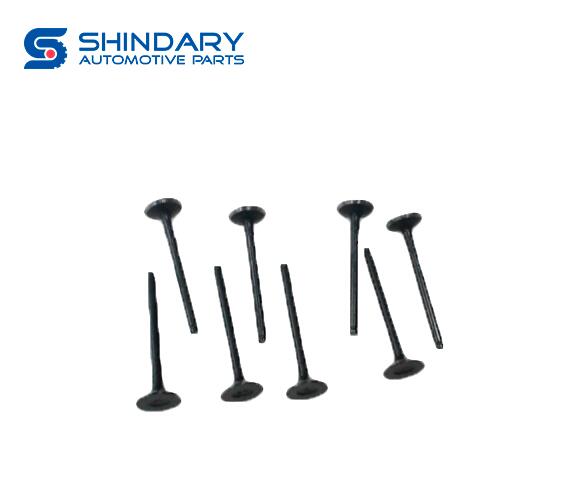Copyright © Shindary Automotive Parts Co., Ltd. All Rights Reserved
Valves are part of the engine and contribute to the combustion process. There are two types of valves. The valve that allows air and/or fuel to enter the combustion chamber is called the intake valve. The valve that allows the exhaust gases to leave the combustion chamber is called the exhaust valve.
Both valves play a very important role, and if one of them fails, the engine will not work properly. Fortunately, you can look out for signs of a damaged or burned out car valve.
Damaged or burnt valves can cause low engine power, misfires, exhaust or throttle body leaks, rough idle, popping sounds and poor gas mileage.

1. Low power and misfire
When an intake or exhaust valve is bad, the engine will produce low power. Usually, this is caused by a burned-out valve. Basically, when combustion gases escape between the valve and valve seat, this causes exhaust gases to erode the exhaust valve, leading to premature failure.
When the valve does not seal completely, cylinder compression will begin to decrease, resulting in low power. You can run a compression test to identify the cylinder that is causing the performance problem. A compression test can also diagnose and determine if there are any worn piston rings, worn cylinder walls, and damaged cylinder gaskets.
Perform a compression test on all cylinders and compare the readings. If compression is low, make sure there is no blue smoke coming from the exhaust, which indicates worn piston rings and cylinder walls. If the blue smoke in the exhaust lasts only 10 minutes, the valves are not sealing properly. When white smoke appears in the exhaust after a compression test, it is a sign of a blown cylinder gasket.
However, if there is faint white smoke with a gasoline smell coming from the exhaust port after a compression test, the valves are not completely sealed and not all of the fuel was not burned during the combustion process. Unburned fuel will eventually cause the catalytic converter to fail. You should replace the valve to avoid premature wear of the parts.
2. Exhaust or throttle body leaks
You can determine if a valve is damaged or burned by running an air leak test.
✱ Rotate the crank pulley until the cylinder is on the compression or do-it-yourself stroke.
✱ Make sure the intake and exhaust valves are closed.
✱Remove the ignition coil and spark plugs.
✱ Using an air compressor, inject air into the cylinder where the spark plugs are located.
If the exhaust valve is bad, you will be able to hear air escaping through the exhaust pipe.
If the intake valve is bad, you will be able to hear air escaping through the intake manifold and throttle body.
At this point, you should replace the bad valve and control the air leak.
3. Remove the cylinder head
Remove the cylinder head and inspect the valve for cracks and missing parts. Take the time to do a thorough inspection. Next, make sure all valves are in the closed position so you can perform a leak test.
✱ To perform a leak test, you can use carburetor cleaner, brake cleaner, or lacquer thinner.
✱ Spray a generous amount of carb cleaner or pour lacquer thinner on the valve seats.
✱ Let it sit for a few minutes.
If the valve is damaged or burned, the cleaning fluid will seep right into the valve and seat. At this point, the top will require machine work.
4. Broken timing chain
A damaged timing belt or timing chain system will cause the valves to hit the cylinder head and bend or break all valves that interfere with the engine. At this point, all damaged valves will need to be replaced. Pistons may also be damaged and need to be replaced if damaged.
5. Unstable idle speed, popping sound, low fuel consumption
When a valve is bad, engine performance suffers. Damaged or burnt valves can lead to increased fuel consumption and erratic idling. In addition, a popping sound can be heard.
At this point, it is best to perform a compression test and leak test to verify if the valve is damaged.
6. Valve noise
When the valve makes ticking, clicking and chattering sounds, it may be that the oil level is low or the valve is bad and needs to be replaced.
First, check the oil level. If the oil level is good, check for possible oil leaks. Next, if the engine is getting high mileage, the valve may need to be adjusted.
Gas flows through the cylinder head, enters through the intake port, and exits through the exhaust port. The intake manifold and intake ports are located on one side of the engine and the exhaust manifold on the other. The job of controlling the gas flow falls to the valves.
Therefore, inside the ports we have only one clear pathway directly into the cylinder and into the combustion chamber. The valve is used to close this passage and open it at the right time. The minimum number of valves required for an engine is two, an intake valve and an exhaust valve.
The reason that today's engines are almost always equipped with four valves per cylinder, and sometimes even with five valves in multi-valve engines is that you can more efficiently move the airflow in and out of the cylinders, which is what makes the engine produce power.
All the engineering in the valves is used to make sure we have efficient gas flow into and out of the cylinders.
Previous: Happy New Year
Shindary Automotive Parts Co., Ltd.